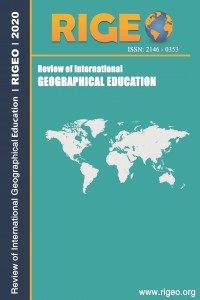Worldview–An Investigation of Japanese and Irish Children’s Geographical Knowledge and Understanding
Worldview–An Investigation of Japanese and Irish Children’s Geographical Knowledge and Understanding
Geography, Social Studies, citizenship, world understanding, misconceptions, school students, Ireland Japan, Japan,
___
- Asakawa, K. (2015). Current status and isses in senior high school geography education. In Y,Ida, M. Yuda, T Shimura, S Ike, K Ohinshi and H Oshima (Eds.) Geography Education in Japan, Tokyo: Springer.39-47.
- Australian Curriculum and Reporting Authority [ACARA] (n/d). Australian Curriculum F-10 Geography, Sydney, ACARA. Available on line at :http://v7-5.australiancurriculum.edu.au/humanities-and-social-sciences/geography/curriculum/f-10?layout=1#level10 [accessed 22/5/19]
- Axia, G., Bremner, J.G., Deluca, P. & Andreasen, G. (1998). Children drawing Europe: the effects of nationality, age and teaching. British Journal of Educational Psychology 16, 423-437.
- Barrett, M. & Farroni, T. (1996). English and Italian children’s knowledge of European geography. British Journal of Developmental Psychology, 14 (3), 257- 273.
- Barrett, M. & Oppenheimer, L. (2011). Findings, theories and methods in the study of children’s national identifications and national attitudes, European Journal of Developmental Psychology, 8 (1), 5-24.
- Bednarz, S, Acheson, G and Bednarz, A (2016 ) Maps and map learning in Social Studies, Social Education 70(7) 398-404 & 432.
- Booth, A (2019) The importance of locational knowledge, Teaching Geography, 44 [2], p81-83.
- Catling, S. & Willy, T. (2009). Teaching Primary Geography, Exeter, UK: Learning Matters Ltd.
- Council on Foreign Relations (2016). What college-age students know about the world: a survey on global literacy. New York: Council on Foreign Relations and National Geographic.
- Department of Education. (1989). Junior Certificate Geography Syllabus, Dublin: The Stationery Office http://www.curriculumonline.ie/getmedia/3c3aec51-89c3-47ca-964c-4bcfa1f62853/JCSEC10_Geography_syllabus.pdf [accessed 22/5/19]
- Department of Education. (2003.) Leaving Certificate Geography Syllabus, Dublin: The Stationery Office. http://www.curriculumonline.ie/getmedia/9da21be1-3f99-4f50-88ee-ba7ce6638e1a/SCSEC17_Geography_syllabus_eng.pdf [accessed 22/5/19]
- Department of Education and Skills. (2017). Languages Connect: Ireland’s strategy for foreign languages instruction¸ Dublin: Department of Education and Skills. https://www.education.ie/en/Schools-Colleges/Information/Curriculum-and-Syllabus/Foreign-Languages-Strategy/fls_languages_connect_strategy.pdf [accessed 9/7/19]
- Donovan, I. (1993). Geographic literacy and ignorance: the study of Dublin adults and schoolchildren, Geographical Viewpoint 21, 73-79. Fernberger, S. W . (1948). Persistence of Stereotypes Concerning Sex Differences. Journal of Abnormal and Social Psychology 43, 97-101.
- Gillmor, D. (1980). Investigation of world place knowledge, Geographical Viewpoint, 9: 58-70.
- Gillmor, D. (1994). International testing in geography, Geographical Viewpoint, 22: 5-20
- Gould, P. and White R. (1986). Mental Maps. London: Allen and Unwin.
- Inokuchi, H. and Nozaki, Y. (2005). “Different than Us”: Othering, Orientalism, and US middle school students' discourses on Japan, Asia Pacific Journal of Education, 25(1), 61-74.
- Klineberg, O. (1951). The scientific study of national stereotypes. International Social Science Bulletin, 3(3), 505-515.
- Le Grange, L. and Beets, P. (2005). Geography Education in South Africa after a decade of democracy. Geography 90(3), pp 267-277.
- Monbukagakusyo [Ministry of Education, Science and Culture] (2008). Cyugakko gakusyu shidou youryo: Syakai(Course of study for junior high school :Social studies). Kyoto: Higashiyama syobou.
- Morgan, J. (2001). Popular culture and geography education, International research in geographical and environmental education, 10 (3), 284-297.
- Ministry of Education. (2014). New Zealand Curriculum, Social Sciences, Wellington: TKI. Available on-line at: http://nzcurriculum.tki.org.nz/The-New-Zealand-Curriculum/Social-sciences/Why-study-the-social-sciences [Accessed 26/6/19]
- Ontario, Ministry of Education (2013). Canadian and World Studies. Toronto: Ontario Government
- Piaget, J. and Weil, A. (1951). The development in children of the idea of the homeland and of relations with other countries, International Social Science Bulletin, 3(3), 561–78.
- Pike, S. (2015). Primary Geography in the Republic of Ireland: Practices, issues and possible futures. Review of International Geographical Research Online, 5 (2), 185-198
- Reynolds, R. & Vinerek, M. (2016). Geographical locational knowledge as an indicator of children’s views of the world: research from Sweden and Australia. International research in geographical and environmental education, 25(1), 68-83.
- Ridgely, D.C. (1912). The teaching of place geography. Journal of Geography 11(1), 13-16.
- Scarfe, N. V. (1950). Geography teaching for international understanding. Paris: UNESCO.
- Shimura, T. (2009). Japanese curriculum reflections, Teaching Geography 34(2), 61-63.
- Taylor, L. (2009). Children constructing Japan: material practices and relational learning, Children's Geographies, 7(2), 173-189.
- Taylor, L. (2015). Research on young people’s understandings of distant places, Geography, 100(2), 110-113.
- Torrens, P.M. (2001). Where in the world? Exploring the factors driving place location knowledge among secondary level students in Dublin, Ireland. Journal of Geography, 100(2): 49-60.
- Waddington, S.B. (2011). Second level geography in Ireland: past, present and future. Geographical Viewpoint 39, 20-30.
- Weigand, P. (1998). Children’s free recall sketch maps of the world on a spherical surface. International Research in Geographical and Environmental Education, 7(1), 67–83.
- ISSN: 2146-0353
- Başlangıç: 2011
- Yayıncı: Eyüp ARTVİNLİ
Applying Virtual Reality Technology to Geoscience Classrooms
Piyaphong CHENRAİ, Sukonmeth JİTMAHANTAKUL
Why Geography Learning: Candidate Teachers’ Views for Geography
Learning Progressions, Paradigms, and Geographic Thinking in the Anthropocene
Thomas LARSEN, John HARRİNGTON, JR.
Maria Anezilany GOMES DO NASCIMENTO
Discovery Learning Strategy in Geographical Education: A Sample of Lesson Design
Psychosocial Achievements of Social Studies Teacher Candidates in Out door Geography CoursesCourses
Worldview–An Investigation of Japanese and Irish Children’s Geographical Knowledge and Understanding
Shelagh WADDİNGTON, Takashi SHİMEDA
Determination of Map Literacy of Undergraduate Geography Students
Out-of-School Learning to Achieve the Spatial Perception Skills: A Case Study
